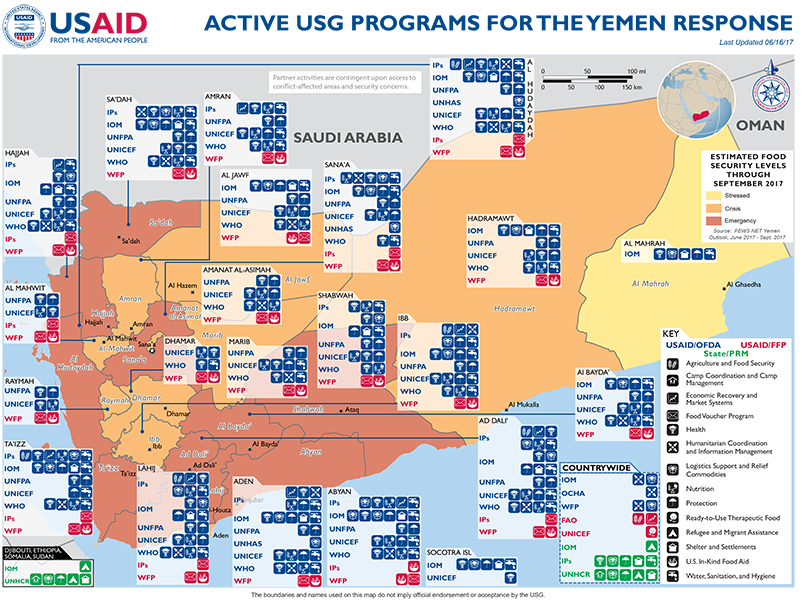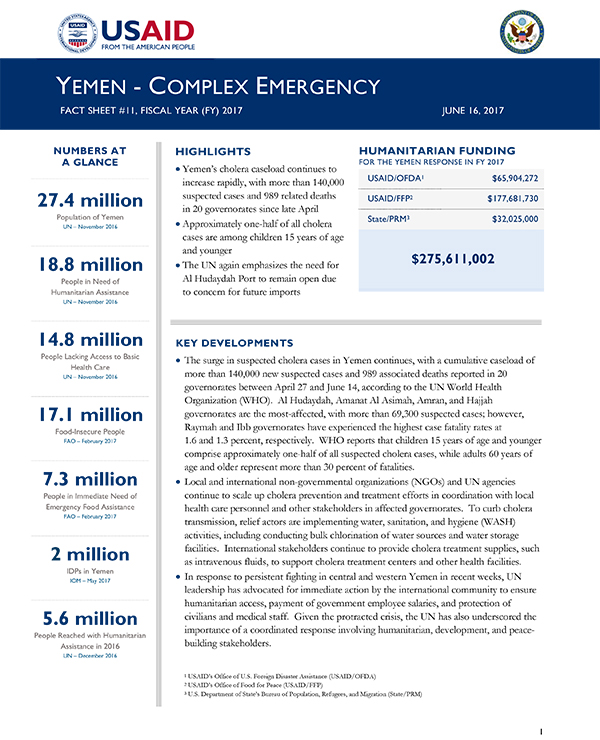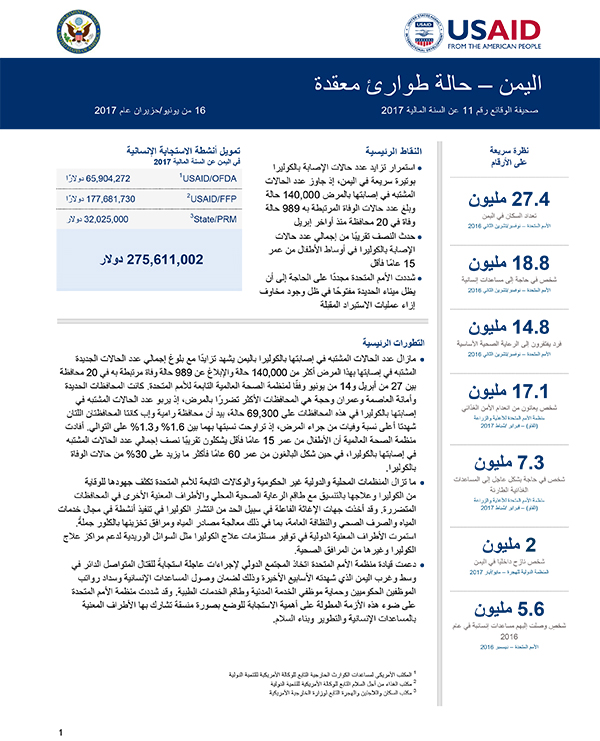- What We Do
- Agriculture and Food Security
- Democracy, Human Rights and Governance
- Economic Growth and Trade
- Education
- Ending Extreme Poverty
- Environment and Global Climate Change
- Gender Equality and Women's Empowerment
- Global Health
- Water and Sanitation
- Working in Crises and Conflict
- Disaster Assistance
- Political Transition Initiatives
- Conflict Mitigation and Prevention
- Countering Violent Extremism
- Disaster Risk Reduction
- Peacebuilding and Reconciliation
- Providing Safe & Secure Environments for Development
- Recovering From Crisis
- Resilience
- Tech Challenge for Atrocity Prevention
- World Humanitarian Day
- U.S. Global Development Lab
June 16, 2017
Highlights
- Yemen’s cholera caseload continues to increase rapidly, with more than 140,000 suspected cases and 989 related deaths in 20 governorates since late April
- Approximately one-half of all cholera cases are among children 15 years of age and younger
- The UN again emphasizes the need for Al Hudaydah Port to remain open due to concern for future imports
Key Developments
Yemen Map - 06-16-2017 ![]() (pdf - 803k)
(pdf - 803k)
Numbers At A Glance
27.4 million
18.8 million
14.8 million
17.1 million
7.3 million
2 million
5.6 million
Humanitarian Funding
For the Yemen Response in
FY 2017
| USAID/OFDA | $65,904,272 |
| USAID/FFP | $177,681,730 |
| State/PRM | $32,025,000 |
| TOTAL | $275,611,002 |
Yemen Complex Emergency Fact Sheet #11 - 06-16-2017 ![]() (pdf - 132k)
(pdf - 132k)
11 اليمن حالة طوارئ معقدة صحٌفة الوقابع رقم ![]() (pdf - 428k)
(pdf - 428k)
The surge in suspected cholera cases in Yemen continues, with a cumulative caseload of more than 140,000 new suspected cases and 989 associated deaths reported in 20 governorates between April 27 and June 14, according to the UN World Health Organization (WHO). Al Hudaydah, Amanat Al Asimah, Amran, and Hajjah governorates are the most-affected, with more than 69,300 suspected cases; however, Raymah and Ibb governorates have experienced the highest case fatality rates at 1.6 and 1.3 percent, respectively. WHO reports that children 15 years of age and younger comprise approximately one-half of all suspected cholera cases, while adults 60 years of age and older represent more than 30 percent of fatalities.
Local and international non-governmental organizations (NGOs) and UN agencies continue to scale up cholera prevention and treatment efforts in coordination with local health care personnel and other stakeholders in affected governorates. To curb cholera transmission, relief actors are implementing water, sanitation, and hygiene (WASH) activities, including conducting bulk chlorination of water sources and water storage facilities. International stakeholders continue to provide cholera treatment supplies, such as intravenous fluids, to support cholera treatment centers and other health facilities.
In response to persistent fighting in central and western Yemen in recent weeks, UN leadership has advocated for immediate action by the international community to ensure humanitarian access, payment of government employee salaries, and protection of civilians and medical staff. Given the protracted crisis, the UN has also underscored the importance of a coordinated response involving humanitarian, development, and peacebuilding stakeholders.
INSECURITY, DISPLACEMENT, AND HUMANITARIAN ACCESS
Airstrikes and fighting in central and western Yemen continue, resulting in increased casualties and compromised humanitarian access to vulnerable populations. The UN reports that approximately 70 percent of people seeking medical care for injuries stemming from heavy fighting in Ta’izz Governorate are women and children. UN leadership continues to advocate for increased access, restoration of public services and payments, and a peaceful resolution to the conflict.
In a May 30 statement to the UN Security Council, UN Under-Secretary-General and Emergency Relief Coordinator (ERC) Stephen O’Brien urged the international community to take immediate action to alleviate the suffering of conflict-affected populations in Yemen. ERC O’Brien advocated for the protection of civilians, all ports and land routes to remain open for humanitarian and commercial imports, and civil servants to receive salaries. The ERC expressed particular concern for people located in governorates experiencing active fighting and airstrikes, such as Al Jawf, Hajjah, Marib, Sa’dah, and Ta’izz. In addition, ERC O’Brien repeated recent UN statements imploring parties to the conflict to ensure that Al Hudaydah Port remains open, and underscored that any attacks at or near the port may drive the Yemeni population into famine. The USAID-funded Famine Early Warning Systems Network (FEWS NET) has also indicated that a significant and extended reduction in imports through Al Hudaydah Port could result in Famine—IPC 5—levels of food insecurity.
In an early June statement, the Permanent Republic of Yemen Government (RoYG) Mission to the UN expressed support for Special Envoy Ahmed’s proposal for Al Hudaydah. The proposal requires Al Houthi forces to withdraw from Al Hudaydah and calls for a technical committee of economists and financial experts to assist RoYG officials in identifying methods to manage RoYG revenues and pay salaries to government employees, international media report.
On June 5, Al Houthi leaders banned Special Envoy Ahmed from Al Houthi-controlled territory, including the capital city of Sana’a, following a UN request for Sana’a authorities to investigate a late May attack on the Special Envoy’s convoy, according to international media. Al Houthi officials accused the Special Envoy of abandoning neutrality and not adhering to UN resolutions related to peace negotiations between parties to the conflict.
FOOD SECURITY AND NUTRITION
Conflict is the primary driver of Yemen’s food security crisis, with more than 60 percent of the population — approximately 17 million people—experiencing Crisis—IPC 3—and Emergency—IPC 4—levels of acute food insecurity, according to the Yemen IPC Technical Working Group. Since an earlier IPC analysis in June 2016, the number of people experiencing Crisis and Emergency levels of food insecurity has increased by 20 percent. Due to worsening health, food security, and WASH conditions, Yemen’s nutrition situation will likely deteriorate further, particularly among vulnerable populations such as children ages five years and younger and women of reproductive age, according to the Nutrition Cluster—the coordinating body for humanitarian nutrition activities, comprising UN agencies, NGOs, and other stakeholders.
In May, the national mean food consumption score declined for the third consecutive month, reaching its lowest level in the past six months, the UN World Food Program (WFP) reports. WFP predicts that poor food consumption—a diet of extremely poor quality and quantity, mainly consisting of bread, oil, and sugar—is likely to worsen as Yemen’s lean season, the period between harvests from April to June, progresses.
The prevalence and severity of acute malnutrition continues to increase in Yemen, with up to 95 districts in 14 governorates exceeding the WHO critical threshold of 15 percent for global acute malnutrition and severely food insecure rates of 20 percent, according to the Nutrition Cluster. Approximately 1.9 million children younger than five years of age are acutely malnourished, including 462,000 children with severe acute malnutrition (SAM) who require immediate treatment. An estimated 900,000 pregnant or nursing women are also acutely malnourished, increasing their vulnerability to maternal mortality and a variety of morbidities.
HEALTH AND WASH
The rapidly spreading cholera outbreak is compounding the humanitarian needs of the population in Yemen, who are already facing conflict, protracted political and economic crises, limited access to health care, and widespread food insecurity and malnutrition. Health actors recorded more than 140,000 suspected cases and 989 related deaths from April 27–June 15; the number of deaths recorded during the past month is almost five times higher than the number of deaths reported from October 2016 to March 2017, according to the Health Cluster. The most-affected populations include children ages 15 and younger—comprising approximately one-half of new suspected cases—and adults ages 60 years and older, who represent 33 percent of fatalities. Humanitarian organizations, including U.S. Government (USG) partners, continue to scale up relief efforts to curb the rapid increase in Yemen’s cholera caseload.
The UN Children’s Fund (UNICEF) projects that the cholera caseload will increase by an additional 127,000 cases before the outbreak peaks, as health workers are currently recording 2,500–3,000 new cases each day; however, technical experts caution that caseload forecasts are unreliable during a cholera outbreak given that a high proportion of infected people do not exhibit symptoms. The UN notes that Yemen’s rainy season may facilitate cholera transmission, particularly as ongoing conflict has severely impacted WASH infrastructure and services.
In response to the renewed cholera outbreak, a WHO-chartered aircraft carrying up to 80 metric tons (MT) of medical supplies, including cholera treatment kits and intravenous fluids, arrived in Sana’a on May 25. The shipment— containing medical supplies sufficient to treat approximately 10,000 patients—is the largest medical supply shipment facilitated by USAID/OFDA partner WHO since March 2015. Prior to the May 25 shipment, WHO distributed nearly 30 cholera treatment kits—benefitting approximately 2,800 people—and more than 115,000 bags of intravenous fluids to rehydrate people in severely-affected districts.
In late May, USAID/OFDA partner UNICEF chartered three planes to transport 40 MT of health and WASH supplies to Sana’a. The supplies included diarrheal disease kits, intravenous fluids, medicines, and oral rehydration salts to treat more than 50,000 patients in Yemen.
As of June 12, Health Cluster members had established approximately 1,900 cholera treatment beds, or approximately 54 percent of the 3,500 beds that health actors anticipate requiring to meet treatment needs. In addition, health actors had established approximately 200 of the nearly 900 oral rehydration points required for treatment. Since early May, WASH Cluster members have distributed one-month supplies of chlorine tablets to an estimated 588,000 people in 11 governorates, while WASH promotional campaigns for water storage cleaning have reach an estimated 617,000 people. Access constraints, lack of health care workers, debilitated health infrastructure, supply and equipment shortages, and other factors challenge organizations’ ability to expand interventions at the pace of the rapidly growing outbreak.
In addition to UN efforts, USAID/OFDA NGO partners continue to implement cholera treatment and prevention efforts through health and WASH interventions. With USAID/OFDA support, relief actors are supporting health workers to treat patients at the community level and refer serious cases to treatment centers; promoting safe WASH practices through community outreach; and supporting bulk chlorination of water supplies, including water networks, water trucks, and household water tanks. As of May 23, a USAID/OFDA NGO partner had delivered safe drinking water to households and facilities to benefit nearly 93,000 people; disseminated hygiene promotion, environmental, and waste collection messaging to nearly 131,000 people; and distributed 2,100 hygiene and cholera treatment kits in response to the outbreak.
A USAID/OFDA partner provided health consultations to nearly 6,900 patients in Abyan, Aden, Ad Dali’, Lahij, Sana’a, and Shabwah governorates from May 1 to 15. The partner provided reproductive health services and referrals to nearly 2,700 women and reached more than 6,400 beneficiaries with health education in the six governorates. The partner enrolled and graduated nearly 280 children from a supplementary feeding program, provided breastfeeding education to 1,500 women, and treated 240 children for SAM in six governorates.
OTHER HUMANITARIAN ASSISTANCE
As of June 16, the 2017 Yemen Humanitarian Response Plan (HRP), which seeks $2.1 billion to meet humanitarian needs, had received nearly $604 million—approximately 29 percent of the total request. To date in 2017, international stakeholders have contributed approximately $871 million to meet needs in Yemen, supporting programs inside and outside the HRP. As of early June, more than 120 humanitarian organizations, including local and international NGOs and UN agencies, were responding to the humanitarian crisis in Yemen.
The Kingdom of Saudi Arabia (KSA) King Salman Humanitarian Aid and Relief Center (KSRelief) continues to provide humanitarian assistance to conflict-and cholera-affected populations in Yemen. KSRelief recently distributed approximately 550 MT of relief assistance—including 700,000 IV fluid bags, 200,000 oral rehydration packets, and medicine supplies—to treat cholera patients. In a June 10 statement, the KSA announced more than $8 million in additional funding to support WHO cholera prevention, diagnosis, and treatment efforts.
CONTEXT
Between 2004 and early 2015, conflict between the RoYG and Al Houthi opposition forces in the north and between Al Qaeda-affiliated groups and RoYG forces in the south affected more than 1 million people and repeatedly displaced populations in northern Yemen, resulting in humanitarian needs. Fighting between RoYG forces and tribal and militant groups since 2011 limited the capacity of the RoYG to provide basic services, and humanitarian needs increased among impoverished populations. The expansion of Al Houthi forces in 2014 and 2015 resulted in the renewal and escalation of conflict and displacement, further exacerbating already deteriorated humanitarian conditions.
In late March 2015, the KSA-led Coalition began airstrikes on Al Houthi and allied forces to halt their southward expansion. The ongoing conflict has damaged public infrastructure, interrupted essential services, displaced many people, and reduced the level of commercial imports to a fraction of the levels required to sustain the Yemeni population. The country relies on imports for 90 percent of its grain and other food sources.
The escalated conflict, coupled with protracted political instability, the resulting economic crisis, rising fuel and food prices, and high unemployment, has left more than half of Yemen’s 27.4 million people food-insecure and more than 7 million people in need of emergency food assistance. In addition, the conflict had displaced nearly 3 million people, including more than 900,000 people who had returned to areas of origin, as of March 2017. The volatility of the current situation prevents relief agencies from obtaining accurate, comprehensive demographic information.
In early 2015, Yemen hosted approximately 248,000 refugees and a large population of third-country nationals (TCNs). The escalation in hostilities prompted International Organization for Migration (IOM) to organize large-scale TCN evacuations from Yemen.
On October 26, 2016, U.S. Ambassador Matthew H. Tueller re-issued a disaster declaration for the complex emergency in Yemen for FY 2017 due to continued humanitarian needs resulting from the complex emergency and the impact of the country’s political and economic crises on vulnerable populations.
PUBLIC DONATION INFORMATION
The most effective way people can assist relief efforts is by making cash contributions to humanitarian organizations that are conducting relief operations. A list of humanitarian organizations that are accepting cash donations for disaster responses around the world can be found at www.interaction.org.
USAID encourages cash donations because they allow aid professionals to procure the exact items needed (often in the affected region); reduce the burden on scarce resources (such as transportation routes, staff time, and warehouse space); can be transferred very quickly and without transportation costs; support the economy of the disaster-stricken region; and ensure culturally, dietary, and environmentally appropriate assistance.
More information can be found at:
- USAID Center for International Disaster Information: www.cidi.org or +1.202.821.1999.
- Information on relief activities of the humanitarian community can be found at www.reliefweb.int.










Comment
Make a general inquiry or suggest an improvement.